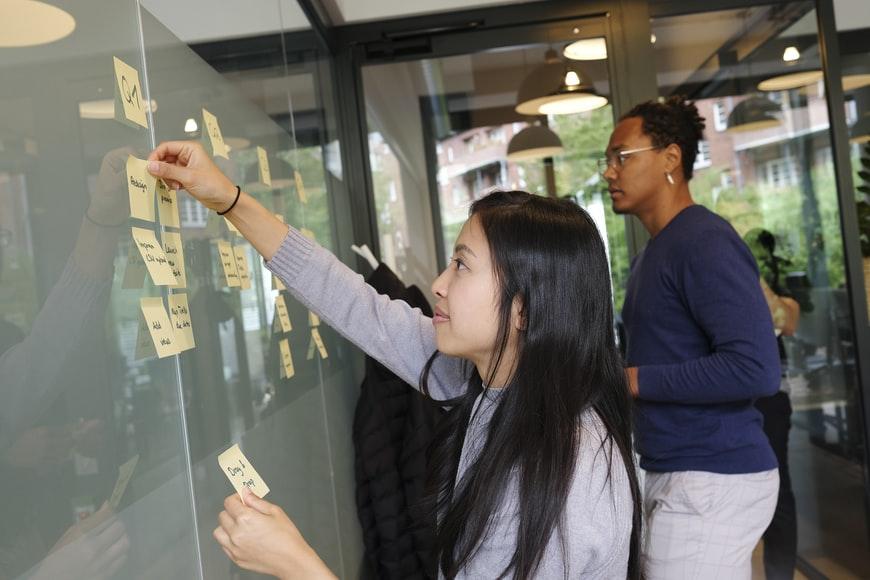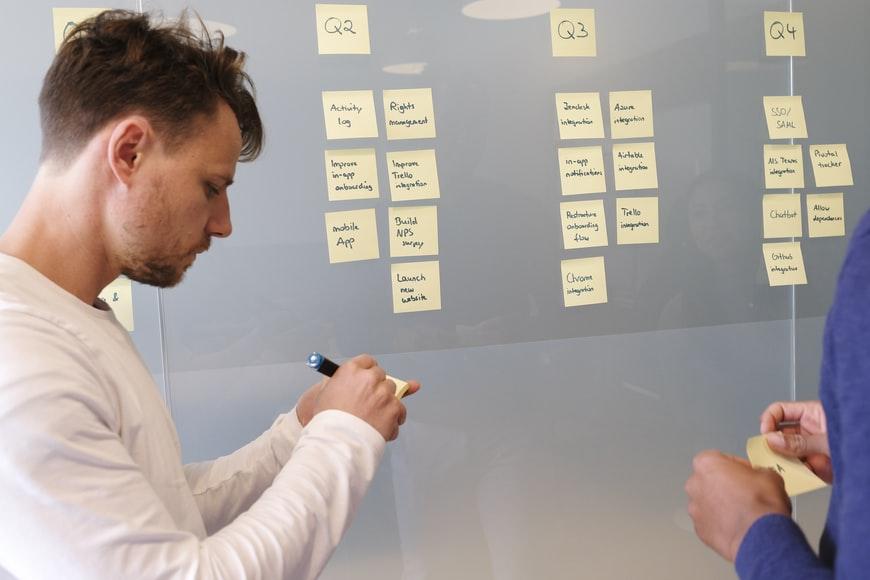Project Thinking: Systematic Thoughts and Actions that Lead to Results
10 Mins Read
Published on: 14 February 2022
Last Updated on: 29 March 2022

toc impalement
Imagine the situation: you are faced with finding a job. And at that moment, you have a lot of questions in your head: “Where do I start? Where to go?
And what do I even want to work for?” You compile your resume, register on a job search site, monitor offers, go to interviews, and there it is, the long-awaited moment, the call from the employer: “You’re hired!” Congratulations! Your project-oriented thinking has led you to your cherished goal.
Every day consists of small and big projects: doing homework, going shopping, and meeting. Sure, you can get through the day intuitively, but it’s not the wisest option. Project thinking will help you in business and education. For example, project thinking will help write my essay on a business topic. So today, we will tell you why project thinking is the basis of the success of a modern person and how to develop it.
What is project thinking?

A project is a question, a problem to be solved in the context of limited resources. For example, a student realizes that the exam is two days away and is not ready.
To pass the exam with “excellent” is his project, or rather the problem. The notion of “problem” implies a mismatch between expectations and reality (the student wants to pass the exam, but he has not even sat down for textbooks yet). Of course, you can hope for luck and the magical power of the universe, but why, if there is a much more reliable option – to connect to the solution of the issue of project thinking.
Project thinking is the ability to clearly define a problem and find ways to solve it with limited resources. It breaks an issue down into separate tasks, looking for inconsistencies and interrelationships between them. Design thinking is about thinking itself and about doing certain things.
With the help of modeling, diagrams, visual representations, and discussions, experiments are conducted, and actions are carried out to find the root of the problem and solve it.
It is possible to learn project thinking, but it requires a lot of practice and repeating similar steps from time to time. It is like learning to play a musical instrument: you can read a manual and listen to the works of other musicians for years, or you can take out your guitar and rub your fingertips on the strings every day, performing the same lesson until perfection in performance is achieved.
Project thinking is a skill that everyone needs, and in some fields, it is a mandatory professional tool, such as technical fields. It helps to solve the problem and predict the outcome of actions to prevent the situation from repeating in the future.
Let’s say you went to an important meeting and realized that you had left your tablet at home and with it your work, which should have been presented to the client. And then you have a few options to solve the problem: ask the family to send the document to the post office and show it from your phone, or send it by courier, or to warn the customer that you will be delayed because you have decided to return home.
The options are identified, now the only thing left is to make sure you don’t get into a similar story again:
- Put a reminder on your phone.
- Put your tablet in your bag in the evening.
- Save documents in the “Cloud” to use them from any device.
Now that there is a rough understanding of how project thinking works, let’s look at the stages of project thinking in detail:
- Problem identification: the primary goal of the project is to solve the problem recognize the problem first.
- Preparation: once the endpoint is identified and you already have an approximate model of the outcome in mind, you need to identify the criteria that will serve as a “beacon” that the task is done.
Project development:
- At this stage, a deadline is set.
- An algorithm of actions is thought through.
- Possible risks are calculated.
- Implementation: The instructions for implementing the project are in hand. Now it’s time to act. It is essential to be as flexible as possible here, as things can change because of unforeseen circumstances.
- Control: Each step should be compared on a plan/actual basis. It will help you to make adjustments in time if something goes wrong.
- Debriefing: The initial goal is compared to the final result at this stage.
At first glance, it seems easy to be a planner. But is it? Each approach to solving problems has its advantages and pitfalls. Let’s consider them in detail.
The pros and cons of project thinking

The realities of today dictate that we have to act with limited resources and always be result-oriented. Just the project type of thinking helps us quickly cope with this. Thanks to this mentality, we can achieve our goals in a short period without losing quality, anticipate risks, react quickly to them and optimize the resources we use.
Project thinking seeks to find the root of the problem and a rational solution that takes minimal effort to implement. Another advantage of this approach is that it does not involve the mechanical execution of tasks but most often requires learning new skills and knowledge.
Despite the weighty arguments “for,” the organization of project thinking, for example, in business has its nuances. According to experts, the difficulties stem from individual constraints and corporate culture. Project thinking differs from the analytical methods used in most companies because it requires the creation of prototypes; otherwise, it is simply impossible to study the problem thoroughly.
Another individual limitation is the lack of practice of this approach. More often than not, it works like this: a team of specialists who have not worked together before is assembled. They are tasked to solve a problem using project thinking.
Still, the mission fails because there is a division within the team: specialists who have something in common unite and are wary of those who use approaches in their work that are unfamiliar to them. Training will help to avoid such situations, and you should start with small projects, which will help create trusting relationships within the team and unite the minds.
The culture of relationships within the organization plays a huge role in the effectiveness of project thinking. If the manager, unlike his team, is not interested in solving the problem in this way or thinks it is a waste of time because there are other priority issues, the project can be derailed. In this case, you need to work on the level of interaction within the hierarchy.
Procter & Gamble’s former CEO and Executive Chairman Alan Lafley had to part ways with almost half of his managers because their views on the culture of project thinking did not match, and they were not interested in developing project thinking in their operations.
As you see, difficulties in applying project thinking techniques may arise if there has not been proper training or if there are specific problems of understanding their meaning within the team. But this is easily solved. Self-education will be the best step towards solving this issue because changing the system starts with changing yourself.
Check out our online program “Cognitive Science”: in just a couple of months, you will learn how to put into practice more than 20 techniques of thinking, which will allow you to make decisions quickly, reason logically and consistently, and find non-standard approaches to problem-solving.
Design Thinking Techniques

Project thinking is not a congenital skill, which means that it is available to absolutely everyone. You need to learn how to manage yourself, people, and plans to do this. Self-management – This is a kind of pedagogy about himself. Having formed a projective way of thinking, we can solve any problem using a minimum of resources.
In his book “Make It Tomorrow,” Mark Forster divides projects into continuous and organizational tasks. Ongoing projects involve regular repetition of similar activities (for example, to learn a foreign language, you need to do several exercises every day, learn new words and practice speaking). Organizational projects consist of several actions that lead to a single goal (e.g., launching an online store).
The outcome of projects depends on the approach chosen. More often than not, people divide things into important and urgent, giving preference to the latter. It leads to an accumulation of essential tasks and constant fuss. The author of the book recommends looking at the concept of “urgent business” differently, implying that if you prioritize urgent tasks in their importance, and not because there is no time to do them at all, things will go much better.
Mark Forster identifies the following principles that will help shape project thinking:
a. Have a clear vision of your goal:
The clearer we are about what we want to achieve in the end, the easier it is to realize what we have in mind. A vision helps us focus and set boundaries for action.
b. Do things one at a time:
Rushing from one task to another is the worst approach to solving an issue. You should always have a clear plan of action and set a cardinal rule: work on one task only at any given time. It is vital when performing routine tasks.
c. Work little by little, but often:
It is unnecessary to do all things in one sitting, especially if labor-intensive work is implied. The human mind is most effective when it works in short periods, but often. So we get less tired have time to think, reflect and compare our actions. It’s like in sports: it’s impossible to build muscles by working out for 12 hours in one day. It will do more harm than good. And working out for half an hour every day will yield visible results.
d. Set boundaries:
Specifying the problem helps to engage the imagination and find as many solutions to the issue as possible. If the problem is not solved or moves too slowly, vague boundaries are likely to cause it.
e. Keep closed lists:
You can’t add anything to such a to-do list, and it, unlike the empty list, does not increase but decreases during the day. The order of the to-do list is irrelevant, and the list itself is like a checklist that helps you get the job done without the distraction of adding more tasks.
To switch to closed lists, you need to isolate the backlog of new studies, organize the system of processing new jobs (you can divide the cases into blocks and discard the issues that are not needed), get rid of unresolved tasks, complete them gradually, not all at once.
Project thinking is a great assistant in education because getting a profession is also a project. The same mistake is often made in the learning process: a person, not reaching a certain peak just a little bit, begins to think that he already knows everything and there is no point in reaching the end.
Experts have called it the illusion of a mountaineer who dreams of reaching the peak, but, knocking his feet down and washing his shoes (in a word, gaining experience), a few steps before the goal, he decides to turn back because he has already seen everything.
So he deprives himself of the opportunity to look at the stunning landscape and to understand that behind this mountain, it turns out, there are even higher mountains, which can be seen only from the cherished top. The learning process should also have a plan: divide your educational path into stages (peaks) and find ways to get to each planned height.
As for managing people, the primary tool is delegation. If you are the kind of person who thinks it is better to do everything yourself, you should learn to trust tasks to other people. Mark Forster recommends not putting off work but delegating it as early as possible.
Be specific in setting the mission, divide the deadline into several intermediate blocks and at the same time leave enough time. For example, if the job needs to be done in 10 days, say that the performer has seven days to do it. Remind yourself about the deadline before it comes and immediately tell you if all the permissible deadlines have already passed.
Delegate when it is more profitable than doing something yourself. It is possible to refuse to prepare food and order it in a restaurant, but it makes no sense if the cost of the order is higher than the time saved. The benefit depends on the performer’s competence, among other things, and this must also be considered.
Another component of project thinking is the ability to manage projects. This type of thinking involves a systematic approach, so here we are talking about building the same management system that will lead to the desired result.
Dragon Dreaming (is a project management methodology, it is a worldwide network that connects people according to their goals and capabilities. The design process is based on a triple win culture, and the outcome is a win for each project participant, the community, and the Earth as a whole. It is what project management looks like, according to the concept:
To summarize
It is being able to think projectively = turning a task into a project activity. It is an approach to achieving goals that focuses on results rather than process, saves resources, and develops additional personal and professional skills. Project thinking is used in the design, construction, marketing, and other professional fields and everyday life when we organize recreation, undergo training, or plan our day.
Project thinking combines creative, systematic, and critical thinking that helps create an image of the future and eliminates abstract conclusions. Viewing a task as a project is vital to develop at an early age because this skill allows you to solve even the most non-standard tasks using various techniques and algorithms. It is one of the critical skills of a successful leader and professional.
Read Also:


















Comments Are Closed For This Article